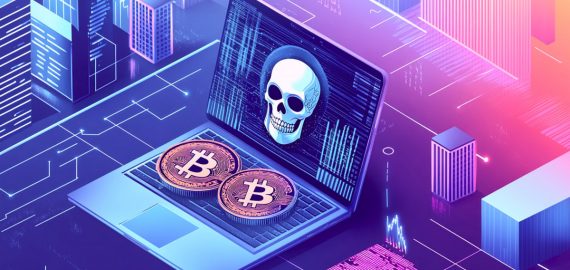Tariffs Just Crashed The Markets: Are We Headed Into A Recession?


In Brief
On October 10th, President Trump’s announcement of 100% tariffs on China triggered a historic market crash, wiping out $1.5 trillion in value across stocks and crypto, raising fears of a potential U.S. recession.

On Friday, October 10th, President Trump put fuel on the fire in his long-running trade war with China, and the markets instantly panicked. He announced 100% tariffs on China, as well as new export bans. Within hours, all markets crashed and investors found their way to gold and silver.
You could feel the fear spread by the minute. Traders started selling, liquidations accelerated everything, and in just a few hours, about $1.5 trillion in market value disappeared. Then, we saw a small rebound. But the question remains: are we at the start of a full-blown recession?
What Exactly Happened
It started with a single Truth Social post on Friday morning. Trump accused China of taking “an extraordinarily aggressive position on trade” and said he’d respond by slapping 100% tariffs on everything China exports to the U.S. starting November 1. He also threatened to block exports of American “critical software” to China.
By the end of the day:
- The S&P 500 was down almost 3%;
- The Nasdaq dropped 3.5%;
- Dow Jones lost nearly 900 points;
- Bitcoin fell from about $122,000 to $104,000 within hours;
- Over $19 billion in crypto positions were wiped out, the largest single-day liquidation in history.
Gold and silver, the classic safe-haven assets, both hit record highs. The message from investors was simple: get out of risk, get into safety.
Why Everyone Panicked So Fast
The U.S. economy has already been showing mixed signals. Growth is slowing, inflation is getting higher again, and hiring is slowing down. Tariffs make all three problems worse. They raise prices, disrupt supply chains, and scare businesses into pausing investment.
Both stock and crypto markets are full of borrowed money through leveraged trades. When investors borrow to buy more assets, gains look great, until prices start to fall. Then the same borrowing turns into a trap. Once prices drop beyond a certain point, brokers and exchanges automatically sell holdings to cover losses. That’s what happened on Friday. It was a chain reaction of forced selling that deepened the crash.
And finally, fear: markets run on confidence. When the president threatens a global trade war and investors don’t know if he means it, confidence vanishes. Traders don’t wait to find out, they just sell.
Inside the Crypto Meltdown
Crypto felt the shock even harder than stocks. Within minutes, hundreds of thousands of traders saw their positions vanish. Dogecoin fell more than 50%. Ethereum lost over 20%. Adding to the chaos, one of Binance’s dollar-pegged stablecoins briefly lost its $1 value as trading volumes spiked. Some platforms even reported temporary outages or “technical glitches,” which only fueled more panic on social media.
By the weekend, Bitcoin had recovered slightly to around $115,000, but the mood was still shaken. Traders called it a “mini black swan”, a sudden shock that reminds everyone how fragile the system can be.
The Monday Rebound, and Why It Might Not Last
By Monday, October 13th, things looked calmer. Trump posted a new message saying, “Don’t worry about China, it will all be fine!” Stocks bounced about 1%, Bitcoin inched up, and headlines began talking about the so-called “TACO trade”, short for Trump Always Chickens Out.
It’s an old market joke: Trump talks tough, markets tank, and then he backtracks just enough to make investors believe everything will be fine again. But even as indexes recovered a little, gold kept climbing and bond yields kept falling, both signs that money is still running for safety. In other words: traders don’t trust this rebound.
Why This Trade War Hits Harder Than the Last One
In 2018-2019, Trump’s first trade war with China caused volatility but never a full-blown crash. Back then, the two sides simply signed a temporary truce and markets kept rising. So what’s different now?
- The tariffs are much larger.
This isn’t 10% or 25%. It’s 100% on all Chinese goods, everything from electronics to clothing to auto parts. - The world is more fragile.
Global supply chains are already having hard times because of the aftermath of the pandemic and the wars. - The U.S. is more leveraged.
Households, corporations, and hedge funds are carrying record debt. When borrowing is high, even small shocks hit harder. - The Fed has less room to maneuver.
Interest rates are already high, and still inflation isn’t down where we want it. The central bank can’t just cut rates without risking another inflation spike.
Put simply: the system has less cushion than it did five years ago. Another prolonged trade war could easily tip it into recession.
The Fed’s Dilemma
The Federal Reserve now faces a classic no-win scenario. They have to try and keep prices stable and employment strong, but those goals are pulling in opposite directions.
If the Fed cuts rates because they want to support jobs, inflation rise again as tariffs push up prices. If it keeps rates high to fight inflation, the job market could weaken further and push the economy into recession.
Economists call this exact situation a trilemma: you can’t have low inflation, low unemployment, and financial stability all at once. One has to give. And right now, the Fed is in between all of them not sure what to do.
Are We Headed for a Recession?
Some experts think we’re closer than most people realize. JPMorgan thinks so. A machine-learning model from Moody’s Analytics, which has correctly predicted every U.S. recession since 1960, now shows a 48% chance of one within the next 12 months. Anything above 50% has always been followed by a downturn.
Several warning signs are flashing:
- Hiring has slowed;
- Consumer spending has plateaued;
- Corporate profits are lowering as input costs rise and demand cools;
- Inflation is creeping back up.
The Fed’s preferred measure, the PCE price index, rose 2.7% in August and is expected to reach 2.9% by year-end. Economists call that mix stagflation, slow growth and rising prices. It’s the toughest environment for both policymakers and investors because traditional tools stop working.
Cutting rates risks more inflation; raising rates risks more layoffs. That’s why many analysts now warn that markets are underestimating risk.
The Complacency Problem
For years, investors have learned that any market drop gets rescued, either by a Fed pivot or by political walk-backs. That creates complacency. Bond yields stay low, investors borrow cheaply, and everyone jumps onto the same trades. It works, until it doesn’t. And then it all falls down quickly.
The danger isn’t that people don’t know the risks. It’s that they think they’ll be able to get out in time. History shows that by the time alarm bells ring, exits are crowded and liquidity disappears. That’s what we saw a glimpse of on Friday: the first real stress test of a market built on optimism and borrowed money.
3 Ways This Could Play Out
Let’s break down the most likely scenarios for the months ahead.
1. Trump Backs Down
Trump signs a partial deal or delays the tariffs. Markets show some relief, stocks rebound, and crypto recovers its footing. This has happened before, several times.
2. The Standoff Drags On
The rhetoric slows down a little, but the tariffs stay in place. Businesses hold off on spending, inflation stays elevated, and markets stay volatile.
3. The Fight Escalates
Tariffs stick, China retaliates, global supply chains seize up, and inflation spikes. The Fed can’t cut rates, growth stalls, and risk assets sink further.
What Are the Pros Saying About This
Analysts are being careful. They say the trade conflict between the U.S. and China can have rippling effects across global markets. Mike Wilson, Morgan Stanley’s chief U.S. equity strategist, warns that investors are underestimating how damaging renewed tariffs could be. He thinks the S&P 500 could fall as much as 10-15% if negotiations break down, saying that markets have been “priced for perfection” since spring. Wilson tells investors to rotate toward defensive sectors like healthcare and utilities, which are less exposed to China-linked supply chains, and to stay cautious in semiconductors and consumer discretionary stocks.
Larry Fink, CEO of BlackRock, agrees with him. He described the new round of tariffs as “beyond anything I could have imagined,” saying they could push the U.S. economy toward recession if maintained. The BlackRock Investment Institute estimates the effective tariff rate could soon reach 20-25%, a level not seen in decades, combining weaker growth with higher inflation, “a toxic mix for risk assets.”
Paul Krugman gives a more structural critique. The Nobel laureate says that despite political rhetoric, the U.S. may actually be more vulnerable than China in a drawn-out trade war. He says that the U.S. remains dependent on Chinese inputs, from consumer goods to critical minerals, while Beijing can offset losses through domestic stimulus. Krugman suggests that tariffs risk doing more harm to U.S. markets than to China’s, as supply-chain disruptions and retaliatory measures deepen.
These perspectives show a rare consensus among analysts who often disagree: the tariff escalation is not noise. It shows a real macro shock, capable of derailing both corporate earnings and investor sentiment.
Why This Moment Matters
Every few years, the market gets a reality check. Friday’s crash wasn’t just about tariffs; it was about fragility. It showed how tightly connected everything has become: stocks, crypto, commodities, politics.
One headline can now ripple through algorithms, trading bots, and global portfolios in seconds. It also showed that fear still works.
For months, investors have been acting as if bad news doesn’t matter. Inflation, deficits, political chaos, wars. Friday reminded everyone that risk never disappears, it just hides until the right spark hits.
Whether this turns into something bigger or just another quick correction will depend on two things: Trump’s next move and the Fed’s response. If both misstep at once, the shockwaves won’t stay contained to crypto charts, they’ll hit jobs, mortgages, and retirement accounts.
Disclaimer
In line with the Trust Project guidelines, please note that the information provided on this page is not intended to be and should not be interpreted as legal, tax, investment, financial, or any other form of advice. It is important to only invest what you can afford to lose and to seek independent financial advice if you have any doubts. For further information, we suggest referring to the terms and conditions as well as the help and support pages provided by the issuer or advertiser. MetaversePost is committed to accurate, unbiased reporting, but market conditions are subject to change without notice.
About The Author
Alisa, a dedicated journalist at the MPost, specializes in cryptocurrency, zero-knowledge proofs, investments, and the expansive realm of Web3. With a keen eye for emerging trends and technologies, she delivers comprehensive coverage to inform and engage readers in the ever-evolving landscape of digital finance.
More articles

Alisa, a dedicated journalist at the MPost, specializes in cryptocurrency, zero-knowledge proofs, investments, and the expansive realm of Web3. With a keen eye for emerging trends and technologies, she delivers comprehensive coverage to inform and engage readers in the ever-evolving landscape of digital finance.


















































